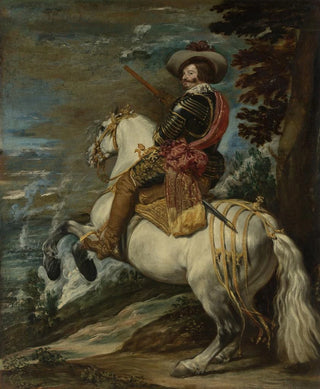Art print Don Gaspar de Guzmán 1587-1645 Count-Duke of Olivares - Diego Velázquez | Reproduction


View from behind

Frame (optional)
The iconic artwork of Diego Velázquez, depicting Don Gaspar de Guzmán, Count-Duke of Olivares, stands as a masterpiece of Spanish Baroque painting. Created in the 17th century, this canvas transcends a simple portrait to become a true declaration of power and prestige. By capturing the very essence of his subject, Velázquez manages to evoke not only Guzmán's aristocratic status but also the psychological complexity of the man behind the title. This piece, both monumental and intimate, invites the viewer to delve into a universe where light and shadow play a crucial role, revealing the nuances of his model's personality.
Style and uniqueness of the work
Velázquez's style, characterized by striking realism, is vividly expressed in this portrait. The composition is carefully balanced, and the artist employs chiaroscuro techniques to emphasize Guzmán's features, highlighting his expressive face and penetrating gaze. The clothing details, from rich fabrics to refined ornaments, testify to unparalleled craftsmanship, while the color palette, subtle and harmonious, creates an atmosphere that is both majestic and accessible. This portrait does not merely depict a man in a position of power; it also captures a human essence, a vulnerability that makes him deeply endearing. Velázquez's mastery in capturing human emotions and characters makes this work a perfect example of 17th-century artistic virtuosity.
The artist and his influence
Diego Velázquez, born in 1599 in Seville, is considered one of the greatest masters of European painting. His artistic journey is marked by an relentless pursuit of perfection and innovation. As a court painter to Philip IV of Spain, he skillfully combined the demands of nobility with his personal artistic vision. Velázquez influenced many artists, both contemporaries and future generations, by introducing innovative techniques, particularly in the use of light and shadow. His impact has been felt through the centuries, inspiring artistic movements

Matte finish

View from behind

Frame (optional)
The iconic artwork of Diego Velázquez, depicting Don Gaspar de Guzmán, Count-Duke of Olivares, stands as a masterpiece of Spanish Baroque painting. Created in the 17th century, this canvas transcends a simple portrait to become a true declaration of power and prestige. By capturing the very essence of his subject, Velázquez manages to evoke not only Guzmán's aristocratic status but also the psychological complexity of the man behind the title. This piece, both monumental and intimate, invites the viewer to delve into a universe where light and shadow play a crucial role, revealing the nuances of his model's personality.
Style and uniqueness of the work
Velázquez's style, characterized by striking realism, is vividly expressed in this portrait. The composition is carefully balanced, and the artist employs chiaroscuro techniques to emphasize Guzmán's features, highlighting his expressive face and penetrating gaze. The clothing details, from rich fabrics to refined ornaments, testify to unparalleled craftsmanship, while the color palette, subtle and harmonious, creates an atmosphere that is both majestic and accessible. This portrait does not merely depict a man in a position of power; it also captures a human essence, a vulnerability that makes him deeply endearing. Velázquez's mastery in capturing human emotions and characters makes this work a perfect example of 17th-century artistic virtuosity.
The artist and his influence
Diego Velázquez, born in 1599 in Seville, is considered one of the greatest masters of European painting. His artistic journey is marked by an relentless pursuit of perfection and innovation. As a court painter to Philip IV of Spain, he skillfully combined the demands of nobility with his personal artistic vision. Velázquez influenced many artists, both contemporaries and future generations, by introducing innovative techniques, particularly in the use of light and shadow. His impact has been felt through the centuries, inspiring artistic movements
12,34 €






